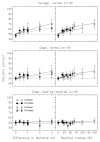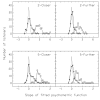The detection of differences in the cues to distance by elderly hearing-impaired listeners
- PMID: 17348530
- PMCID: PMC3563070
- DOI: 10.1121/1.2404927
The detection of differences in the cues to distance by elderly hearing-impaired listeners
Abstract
This experiment measured the capability of hearing-impaired individuals to discriminate differences in the cues to the distance of spoken sentences. The stimuli were generated synthetically, using a room-image procedure to calculate the direct sound and first 74 reflections for a source placed in a 7 x 9 m room, and then presenting each of those sounds individually through a circular array of 24 loudspeakers. Seventy-seven listeners participated, aged 22-83 years and with hearing levels from -5 to 59 dB HL. In conditions where a substantial change in overall level due to the inverse-square law was available as a cue, the elderly hearing-impaired listeners did not perform any different from control groups. In other conditions where that cue was unavailable (so leaving the direct-to-reverberant relationship as a cue), either because the reverberant field dominated the direct sound or because the overall level had been artificially equalized, hearing-impaired listeners performed worse than controls. There were significant correlations with listeners' self-reported distance capabilities as measured by the "Speech, Spatial, and Qualities of Hearing" questionnaire [S. Gatehouse and W. Noble, Int. J. Audiol. 43, 85-99 (2004)]. The results demonstrate that hearing-impaired listeners show deficits in the ability to use some of the cues which signal auditory distance.
Figures













Similar articles
-
Recognition of accented and unaccented speech in different maskers by younger and older listeners.J Acoust Soc Am. 2013 Jul;134(1):618-27. doi: 10.1121/1.4807817. J Acoust Soc Am. 2013. PMID: 23862836 Free PMC article.
-
The impact of temporal fine structure and signal envelope on auditory motion perception.PLoS One. 2020 Aug 21;15(8):e0238125. doi: 10.1371/journal.pone.0238125. eCollection 2020. PLoS One. 2020. PMID: 32822439 Free PMC article.
-
Effects of hearing-aid dynamic range compression on spatial perception in a reverberant environment.J Acoust Soc Am. 2017 Apr;141(4):2556. doi: 10.1121/1.4979783. J Acoust Soc Am. 2017. PMID: 28464692
-
Can basic auditory and cognitive measures predict hearing-impaired listeners' localization and spatial speech recognition abilities?J Acoust Soc Am. 2011 Sep;130(3):1542-58. doi: 10.1121/1.3608122. J Acoust Soc Am. 2011. PMID: 21895093
-
Selective attention in normal and impaired hearing.Trends Amplif. 2008 Dec;12(4):283-99. doi: 10.1177/1084713808325306. Epub 2008 Oct 30. Trends Amplif. 2008. PMID: 18974202 Free PMC article. Review.
Cited by
-
Effects of Varying Reverberation on Music Perception for Young Normal-Hearing and Old Hearing-Impaired Listeners.Trends Hear. 2018 Jan-Dec;22:2331216517750706. doi: 10.1177/2331216517750706. Trends Hear. 2018. PMID: 29320944 Free PMC article.
-
The effect of hearing-aid compression on judgments of relative distance.J Acoust Soc Am. 2010 Jan;127(1):9-12. doi: 10.1121/1.3268505. J Acoust Soc Am. 2010. PMID: 20058945 Free PMC article.
-
An Auditory Illusion of Proximity of the Source Induced by Sonic Crystals.PLoS One. 2015 Jul 29;10(7):e0133271. doi: 10.1371/journal.pone.0133271. eCollection 2015. PLoS One. 2015. PMID: 26222281 Free PMC article.
-
Perception of Auditory Distance in Normal-Hearing and Moderate-to-Profound Hearing-Impaired Listeners.Trends Hear. 2019 Jan-Dec;23:2331216519887615. doi: 10.1177/2331216519887615. Trends Hear. 2019. PMID: 31774032 Free PMC article.
-
Partial Visual Loss Affects Self-reports of Hearing Abilities Measured Using a Modified Version of the Speech, Spatial, and Qualities of Hearing Questionnaire.Front Psychol. 2017 Apr 12;8:561. doi: 10.3389/fpsyg.2017.00561. eCollection 2017. Front Psychol. 2017. PMID: 28446890 Free PMC article.
References
-
- Allen JB, Berkley DA. Image method for efficiently simulating small-room acoustics. J. Acoust. Soc. Am. 1979;65:943–950.
-
- Ashmead DH, Davis DL, Northington A. Contribution of listeners’ approaching motion to auditory distance perception. J. Exp. Psychol. Hum. Percept. Perform. 1995;21:239–256. - PubMed
-
- Ashmead DH, LeRoy D, Odom RD. Perception of the relative distances of nearby sound sources. Percept. Psychophys. 1990;47:326–331. - PubMed
-
- Bench J, Bamford J. Speech-hearing tests and the spoken language of hearing impaired children. Academic Press; London: 1979.
Publication types
MeSH terms
Grants and funding
LinkOut - more resources
Full Text Sources
Miscellaneous

